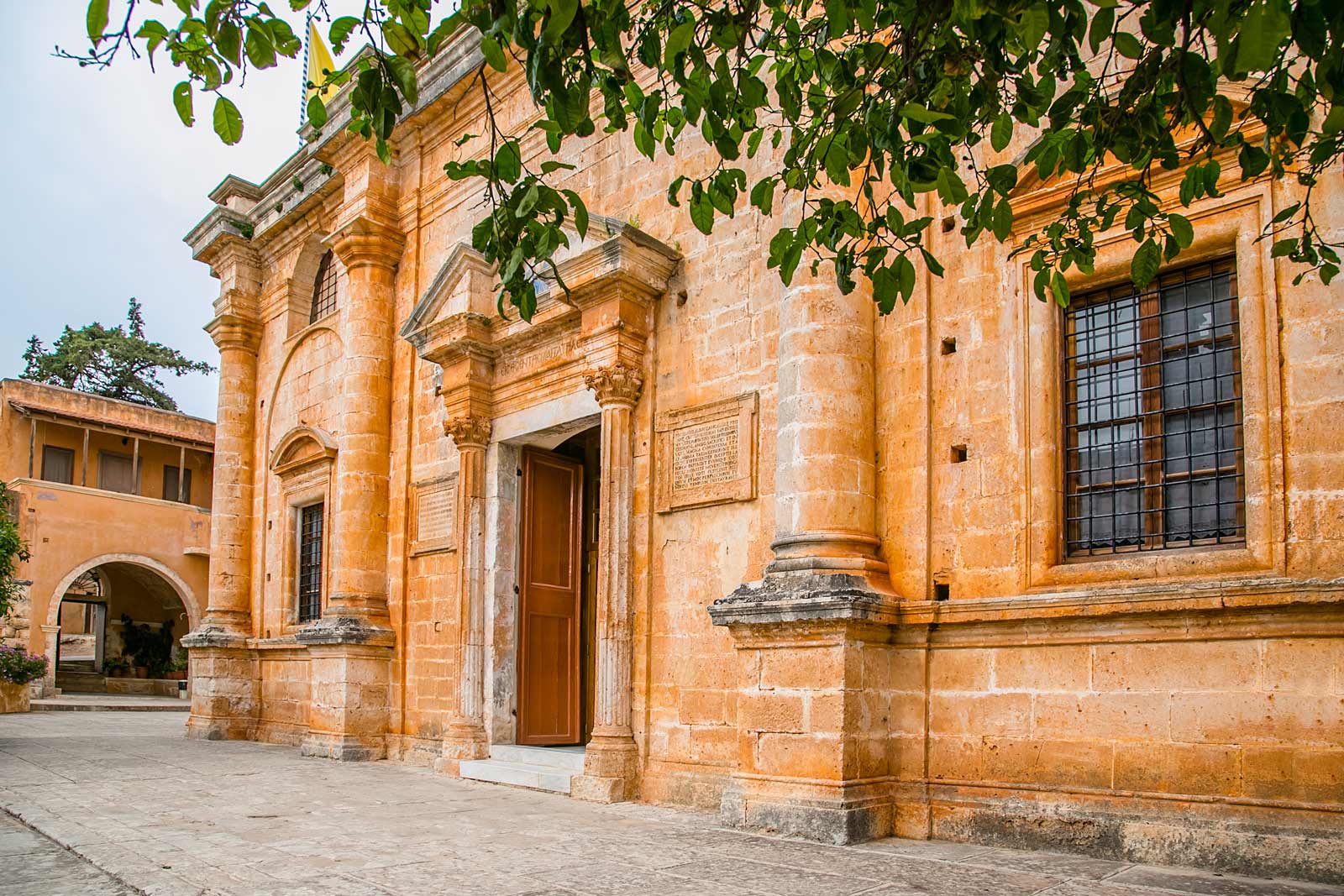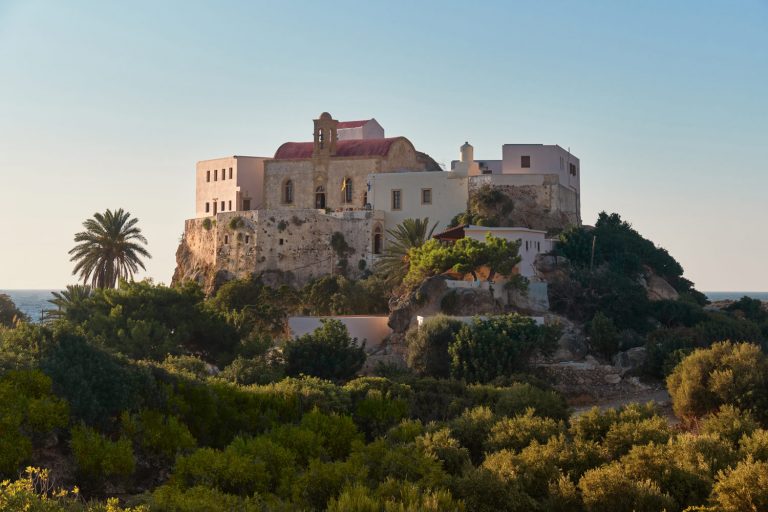
CHRISOSKALITISSA MONASTERY
The monastery of Chrisoskalitissa is one of the most known monasteries in Crete. It is located 75 km southwest of Chania city, and just a few kilometers north of the famous Elafonissi beach. It is built on top of a hill overlooking the rocky, rugged coastline of the area on the west coast of Crete.
The unique name “Chrisoskalitissa” is in Greek the short word for “Virgin of the Golden Step”. According to the legend, when the Ottomans conquered Crete, the nuns hid the golden artefacts of the monastery under a step in the long staircase of the entrance, to protect them from looting. The “golden step”, as it was called, gave its name to the monastery. The legend also says that the non-Christians and the sinners could not distinguish the golden step among the 90 steps of the monastery, which was only visible to the faithful.
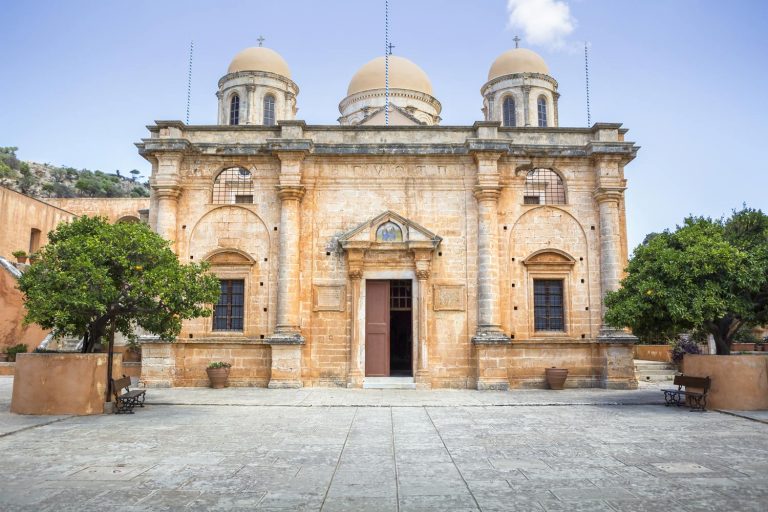
AGIA TRIADA TZAGAROLI MONASTERY
Agia Triada (Holy Trinity) Tzagaroli monastery is arguably one of the most beautiful monasteries in Chania region, located on the north part of the Akrotiri peninsula. It was built in the 17th century by the brothers Ieremias and Lavrentios Tzagaroli, who were monks in the nearby Gouverneto monastery and belonged to a known Venetian-Cretan family with big influence to both the Orthodox and the Catholic Venetian population of the island.
The monastery had a prominent role in the history and the education of Crete. The monastery architecture is remarkable, with elements of the Venetian Renaissance era, and with a strongly fortified wall, where you can go up and walk, enjoying a great view to the monastery from above. Maybe the protagonists of the monastery are its friendly cats, which you can find everywhere. In the monastery there is an interesting museum, where you can also find excellent olive oil and wine, produced from the olive groves and the vineyards of the surrounding area, which belong to the monastery.
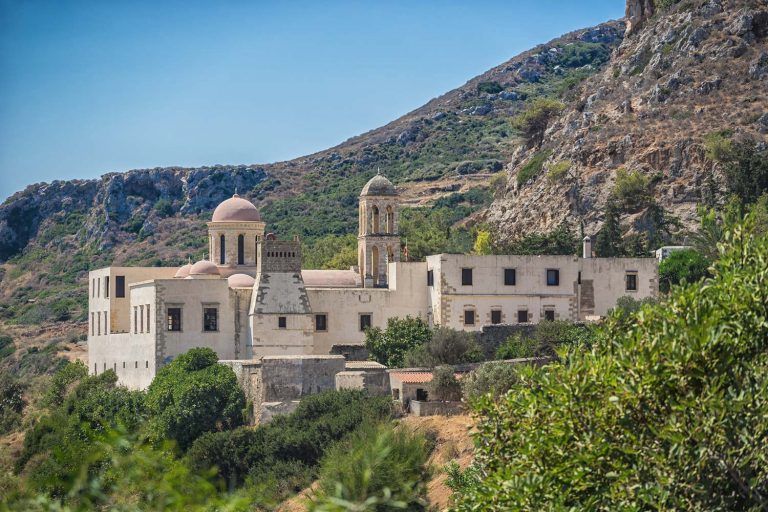
GONIA MONASTERY
Gonia Monastery is one of the most important monasteries in the northwest of Chania region. Its other name is Monastery of Panagia Odigitria, meaning “Monastery of Mother Mary the Leader” in Greek. It is built just outside Kolymbari village, in a distance of less than a kilometer away. The name “Gonia Monastery” means in Greek “Monastery of the Corner”, due to its excellent location on the south of Rodopou peninsula, which provides ample view to Chania Bay.
The distinct architecture of the monastery is complemented by the very interesting Ecclesiastical Museum located inside the monastery. In the museum you can find, among others, icons painted by great artists from the 14th century onwards, and centuries-old manuscripts. During the Ottoman occupation of Crete, the monastery played a large role in the final independence of the island, as it supported and sometimes hosted the Cretan rebels. For this reason it was repeatedly bombarded by the Ottomans, but it was rebuilt every time by its active monks.
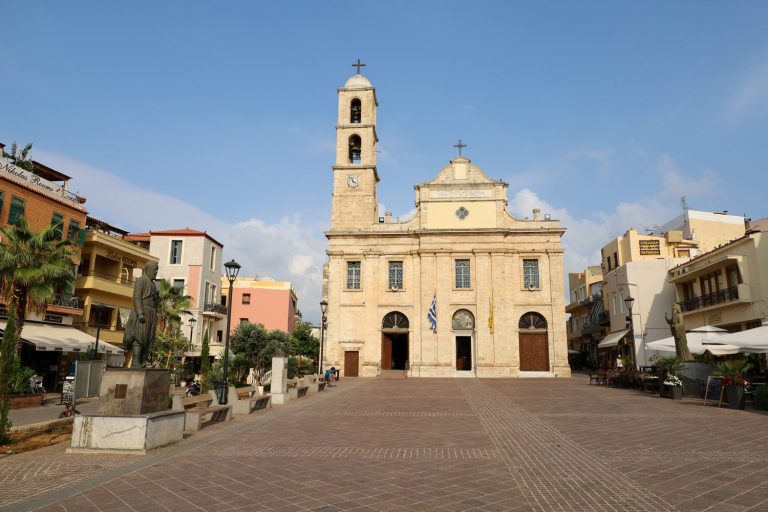
TRIMARTIRI CATHEDRAL
Trimartiri church is the impressive Metropolitan Cathedral of Chania city. It is located in the middle of Chalidon street, the central street of Chania Old Town. In front of the cathedral lies is a nice square with nicel shops around it. The church is called “Trimartiri” (meaning “of the three martyrs” in Greek), due to its three aisles.
It is dedicated to the Presentation of Virgin Mary. The first church on the site was built in the 14th century by the Venetians. The Ottomans later desecrated the church and turned it into a soap factory. During that time, on a corner of the building there was the sacred icon of the Presentation of Virgin Mary, and it became an unofficial shrine for the Christians of Chania city. In the middle of the 19th century, the soap factory was almost bankrupt, and there was unrest among the local Christians, who demanded it to become a Christian church again. This happened in 1860, when the present-day Trimartiri church was built. In the years that followed, the church sustained heavy damages in the Cretan revolution of 1897 and again in the Nazi bombardment of Crete in 1941, but each time it was rebuilt to its former glory.
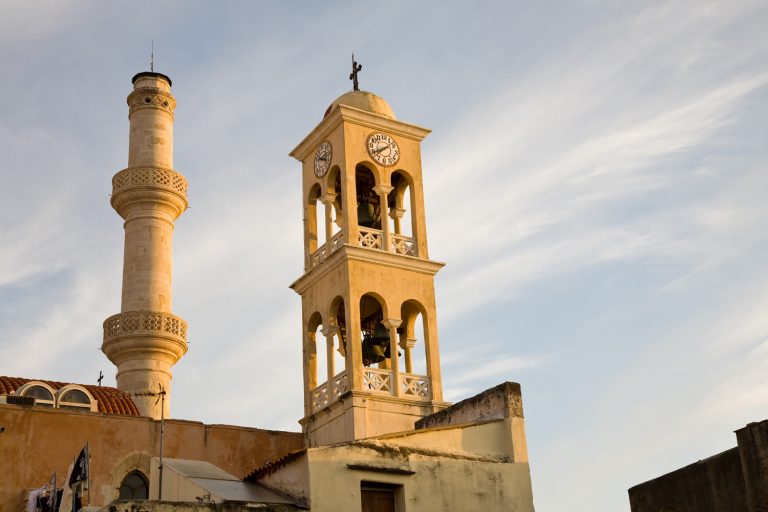
AGIOS NIKOLAOS CHURCH
Agios Nikolaos church is located on the side of one of the nicest squares in Chania city: Splantzia square (or 1821 square, as it is officially called), lying in the center of the homonymous Splantzia quarter. In spring and summer, the shady square with the big trees comes alive by the buzzing cafes, taverns and shops around it.
Agios Nikolaos church was built between the 13th and the 14th centuries as a Dominican monastery, and this is the reason for its distinct architecture. During the Ottoman occupation of Crete, it was converted to a mosque, like all the other Christian churches in Chania city. It was at that period that the tall minaret was built on the corner of the church, which has been recently restored. The building became a church again in 1918, after the liberation and reunion of Crete with Greece, and it was dedicated to Agios Nikolaos, the patron saint of the sailors. Today, it is the only church in Greece that has both a bell tower and a minaret. And if you are observant, you will also find the “secret” underground fountain, after descending the stairs in front of the church…
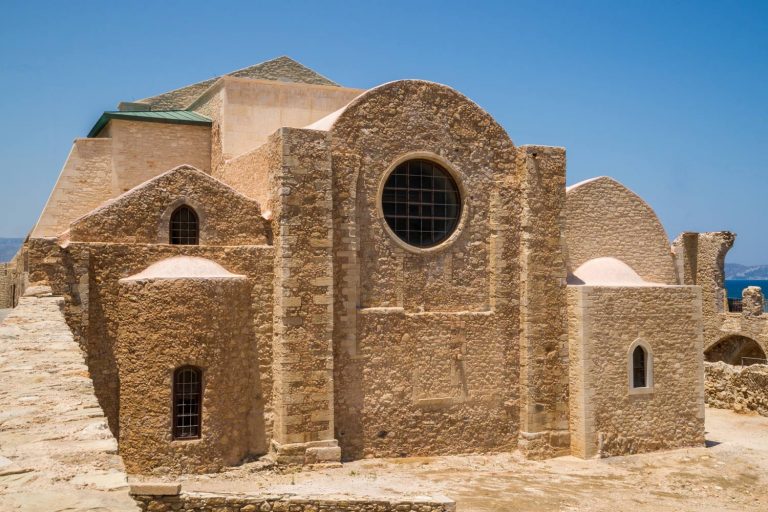
CHURCH OF ST. PETER DOMINICANS
The impressive Church of Saints Peter and Paul was built in the 12th century, in the early years of the Venetian era of Crete, and it was the church of the Dominican monastery of Heraklio. The church, located in the middle of the seaside wall of Heraklio, has very unique architecture, and it is one of the oldest monuments of Cistercian monks in Europe.
The church of Saints Peter and Paul was a work in progress for centuries, as new chapels were added through time. Between the 14th and the 18th centuries, it was repeatedly destroyed by earthquakes and rebuilt again. In recent years, the church is being masterfully restored. In the area surrounding the church, numerous interesting findings have been unearthed from various historical periods of Crete, making it one of the most promising excavation sites in Heraklio.
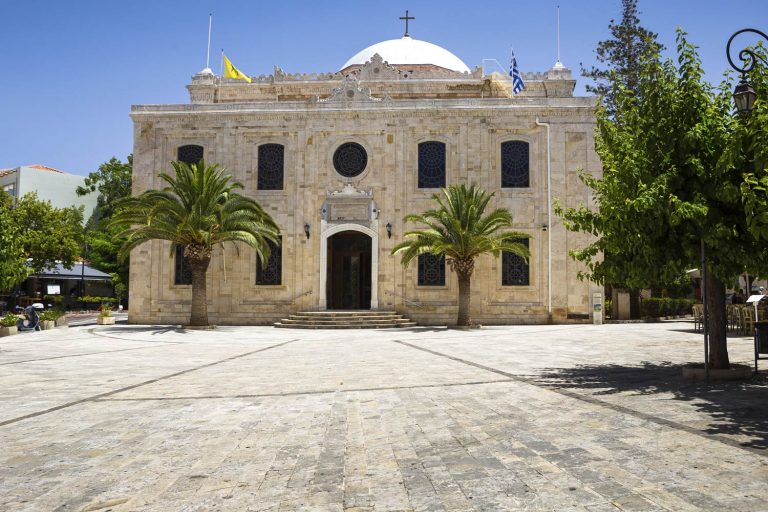
AGIOS TITOS
Agios Titos church is located in the very center of Heraklio, right next to the city hall. It is the oldest church in the city: It was first built in the 10th century, to commemorate the liberation of Crete from the Arabs and its return to the Byzantine Empire. With more than 150m in length, it was one of the longest Basilicas in Greece.
In the centuries that followed, Agios Titos was repeatedly destroyed by earthquakes or fire, but every time it was rebuilt according to its original architectural plan, always serving as the main church of the city. In the years of the Ottoman occupation, the church was converted to a mosque. In 1966, many years after the liberation of Crete and its reunion with Greece, the most precious relic of the church, the skull of Agios Titos, was returned to Heraklio from Venice, where it had been relocated centuries ago to save it from the Ottomans.
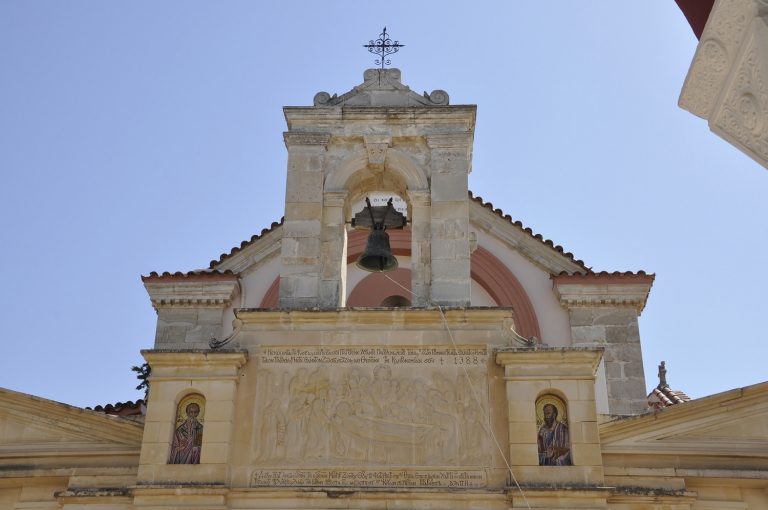
PANAGIA KALIVIANI MONASTERY
Panagia Kaliviani is a known monastery in a distance of about 60 km southwest from Heraklio city, close to the villages of Mires and Kalivia. The three-aisled new church of the monastery is relatively new, built in 1924, and it is dedicated to Virgin Mary (“Panagia” in Greek). However, the first monastery in the site was built in the 10th century during the Byzantine era.
The first monastery was destroyed by the Ottomans when they occupied Crete. From the older monastery, the only building remaining is the small church of Zoodochos Pigi dating back to the 14th century. The monastery is very active in philanthropy and has its own orphanage since 1956.In the monastery premises there are also a home for elder people, a children and teenagers protection center, and a primary and nursery school for the children of the institutions, among others.
